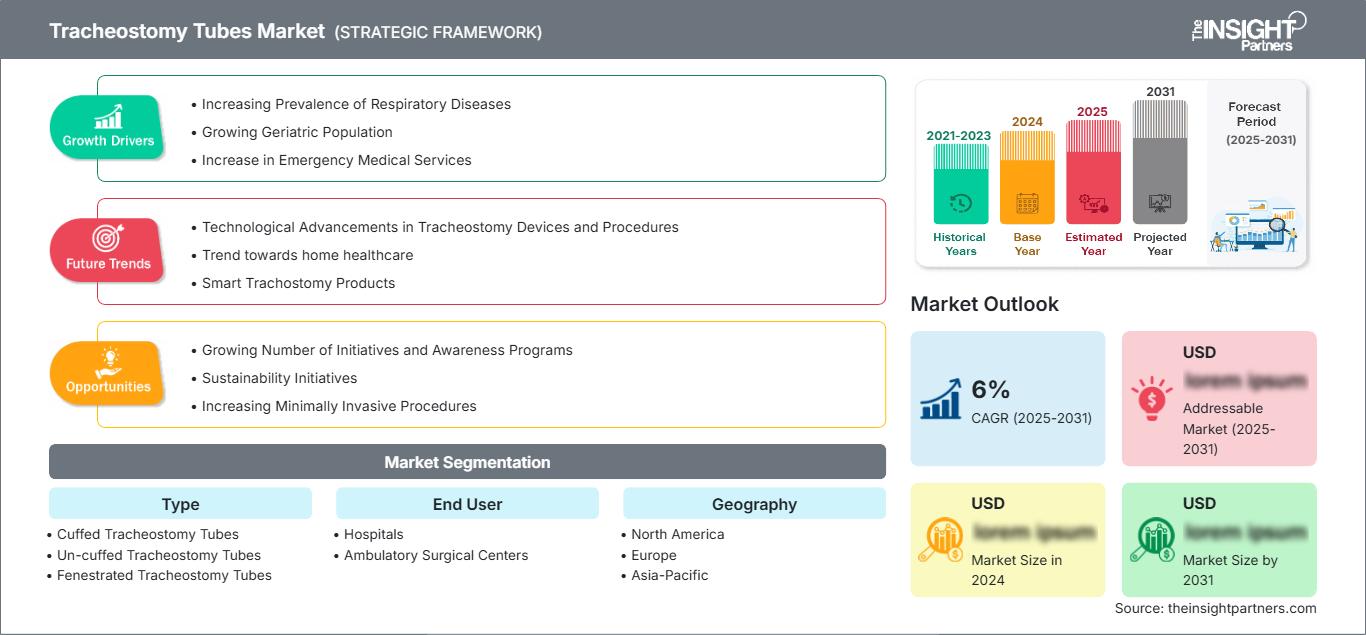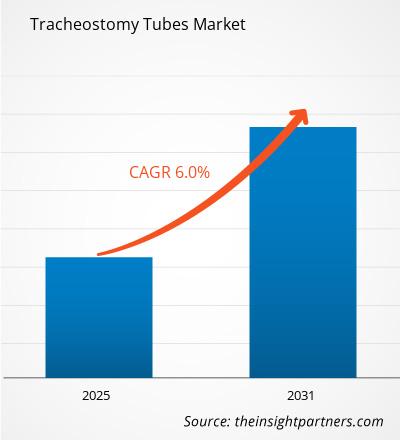Si prevede che il mercato delle cannule tracheostomiche raggiungerà i 3,78 miliardi di dollari entro il 2031. Si prevede che il mercato registrerà un CAGR del 5,4% nel periodo 2025-2031.
Il rapporto è segmentato per tipologia (cannule tracheostomiche cuffiate, cannule tracheostomiche non cuffiate, cannule tracheostomiche fenestrate, cannule tracheostomiche non fenestrate, cannule tracheostomiche a singola cannula, cannule tracheostomiche a doppia cannula). Inoltre, il mercato è segmentato in base all'utente finale (ospedali, cliniche e altri). L'analisi globale è ulteriormente suddivisa a livello regionale e per i principali paesi. Il rapporto offre il valore in USD per l'analisi e i segmenti sopra indicati.
Scopo del rapporto
Il rapporto sul mercato delle cannule tracheostomiche di The Insight Partners mira a descrivere il panorama attuale e la crescita futura, i principali fattori trainanti, le sfide e le opportunità. Ciò fornirà spunti a vari stakeholder aziendali, come:
- Fornitori/produttori di tecnologia: per comprendere le dinamiche di mercato in evoluzione e conoscere le potenziali opportunità di crescita, consentendo loro di prendere decisioni strategiche informate.
- Investitori: per condurre un'analisi completa delle tendenze in merito al tasso di crescita del mercato, alle proiezioni finanziarie di mercato e alle opportunità esistenti lungo la catena del valore.
- Enti di regolamentazione: per regolamentare le politiche e le attività di controllo sul mercato con l'obiettivo di ridurre al minimo gli abusi, preservare la fiducia degli investitori e sostenere l'integrità e la stabilità del mercato.
Tipo di segmentazione del mercato dei tubi tracheostomici
- Tubi tracheostomici cuffiati
- Tubi tracheostomici non cuffiati
- Tubi tracheostomici fenestrati
- Tubi tracheostomici non fenestrati
- Tubi tracheostomici a cannula singola
- Tubi tracheostomici a cannula doppia
Utente finale
- Ospedali
- Centri chirurgici ambulatoriali
Potrai personalizzare gratuitamente qualsiasi rapporto, comprese parti di questo rapporto, o analisi a livello di paese, pacchetto dati Excel, oltre a usufruire di grandi offerte e sconti per start-up e università
Mercato dei tubi tracheostomici: Approfondimenti strategici

-
Ottieni le principali tendenze chiave del mercato di questo rapporto.Questo campione GRATUITO includerà l'analisi dei dati, che vanno dalle tendenze di mercato alle stime e alle previsioni.
Fattori di crescita del mercato delle cannule tracheostomiche
- Aumento della prevalenza di malattie respiratorie: gli stadi avanzati di patologie come il cancro ai polmoni, l'asma e la broncopneumopatia cronica ostruttiva (BPCO) spesso richiedono procedure di tracheostomia per il supporto ventilatorio. Inoltre, i casi gravi di malattie infettive come la tubercolosi, la polmonite e l'influenza portano a insufficienza respiratoria, aumentando così la necessità di tracheostomia. I pazienti in condizioni critiche affetti da COVID-19 necessitano di ventilazione assistita da tracheostomia. Secondo il World Cancer Research Fund International, nel 2023 il cancro ai polmoni è diventato il tipo di cancro più comune al mondo. Nel 2022, si sono verificati 2.480.675 nuovi casi di cancro ai polmoni. Pertanto, la crescente prevalenza di malattie respiratorie crea un onere per i sistemi sanitari, aumentando così la domanda di trattamenti di tracheostomia.
- Crescita della popolazione geriatrica: l'invecchiamento porta a una riduzione della funzionalità polmonare e a una maggiore suscettibilità alle malattie respiratorie. La popolazione geriatrica è più incline a BPCO, polmonite, asma e altre malattie respiratorie. La maggior parte dei paesi in tutto il mondo sta assistendo a un aumento della popolazione geriatrica. Con il 28% della popolazione geriatrica, il Giappone è leader mondiale, seguito dall'Italia con il 23%. Finlandia, Portogallo e Grecia sono tra i primi cinque paesi con circa il 22% della popolazione geriatrica. Pertanto, la crescente popolazione geriatrica alimenta la crescita del mercato della tracheostomia.
- Aumento dei servizi medici di emergenza: un maggiore utilizzo dei prodotti per tracheostomia nei servizi medici di emergenza (EMS) dimostra ulteriormente il crescente riconoscimento della loro importanza in condizioni critiche. Questo perché l'applicazione di protocolli di gestione rapida delle vie aeree aumenta i requisiti di formazione degli operatori EMS per eseguire la procedura ove appropriato, in particolare in caso di traumi gravi o in caso di fallimento dell'intubazione convenzionale. Tutti questi aspetti spiegano perché i servizi di emergenza sanitaria (EMS) utilizzano sempre più prodotti per tracheostomia, favorendo così migliori risultati per i pazienti in situazioni critiche.
Tendenze future del mercato delle cannule tracheostomiche
- Progressi tecnologici nei dispositivi e nelle procedure per tracheostomia: i progressi tecnologici nei dispositivi e nelle procedure per tracheostomia stanno migliorando i risultati per i pazienti, la sicurezza e l'efficienza complessiva della gestione della tracheostomia. Alcune cannule tracheostomiche sono realizzate con materiali avanzati come silicone e poliuretano, tra gli altri, che sono più flessibili, biocompatibili e meno inclini a causare irritazioni o danni ai tessuti. Ad esempio, Medtronic offre a Shiley una cannula tracheostomica flessibile, un materiale morbido realizzato con un plastificante non-DEHP. Questi materiali riducono il rischio di infezione e migliorano il comfort del paziente.
- Tendenza verso l'assistenza domiciliare: l'utilizzo di prodotti per l'assistenza domiciliare con tracheostomia è diventato un requisito sempre più essenziale a causa delle ragioni generalmente estrinseche che guidano questa tendenza, poiché ciò migliorerà l'assistenza e la qualità della vita del paziente. Molti pazienti ora richiedono un supporto ventilatorio prolungato; questo perché condizioni respiratorie croniche o disturbi neuromuscolari li hanno costretti a cercare supporto a lungo termine nelle loro case. I nuovi prodotti per tracheostomia, come i ventilatori portatili o i sistemi di umidificazione, sono stati creati specificamente per l'uso domiciliare e quindi appaiono più accessibili e facili da gestire. Questi fattori contribuiscono a una crescente tendenza verso l'utilizzo di prodotti per tracheostomia in contesti di assistenza domiciliare, migliorando l'indipendenza del paziente e la qualità della vita complessiva.
- Prodotti per tracheostomia intelligenti: diversi fattori che facilitano l'assistenza al paziente e migliorano i risultati stanno aumentando la domanda di dispositivi per tracheostomia intelligenti. Il monitoraggio in tempo reale dei parametri vitali e dello stato delle vie aeree tramite sensori è per lo più integrato nei dispositivi per tracheostomia intelligenti, consentendo così agli operatori sanitari di rilevare probabili complicazioni in tempo. Questi dispositivi possono raccogliere e analizzare dati relativi al flusso d'aria del paziente, ai livelli di ossigeno e alle caratteristiche respiratorie. Tali informazioni possono essere utilizzate per personalizzare l'assistenza e adattare il trattamento di conseguenza. Tutti questi fattori stanno aumentando la domanda di dispositivi per tracheostomia intelligenti di alto valore, sia in ambito acuto che domiciliare.
Opportunità di mercato per le cannule tracheostomiche
- Numero crescente di iniziative e programmi di sensibilizzazione: alcune iniziative governative si concentrano sul miglioramento dell'accessibilità e sulla promozione dell'innovazione nel campo della tracheostomia. Ad esempio, la Global Tracheostomy Collaborative (GTC) è un'organizzazione collaborativa per il miglioramento della qualità che offre la migliore assistenza tracheostomica in tutto il mondo e aiuta il personale, i dirigenti, i pazienti e le loro famiglie a implementare rapidamente le migliori pratiche nelle strutture sanitarie. Questa collaborazione mira a lavorare insieme per migliorare l'assistenza, la sicurezza e la qualità della vita dei pazienti sottoposti a tracheostomia.
- Iniziative per la sostenibilità: le misure per la sostenibilità relative alle cannule tracheostomiche e a tutti i dispositivi associati sono elementi chiave per la riduzione dell'impatto ambientale degli operatori sanitari. Le cannule tracheostomiche biodegradabili e riciclabili riducono l'impatto ambientale della plastica. Ciò pone sfide significative per i produttori in termini di sostituzione dei materiali senza compromettere sicurezza e funzionalità. I gruppi ambientalisti formano un'alleanza che consente alle strutture sanitarie di adottare le migliori pratiche per la sostenibilità, continuando a impegnarsi per ridurre l'impatto ambientale dell'assistenza sanitaria. Gli sforzi per la sostenibilità non solo aiutano l'ambiente, ma sono anche in linea con la crescente domanda di pratiche sanitarie responsabili.
- Aumento delle procedure mini-invasive: i prodotti per tracheostomia sono stati sempre più utilizzati negli interventi chirurgici mini-invasivi, soprattutto quando può essere richiesta una gestione più avanzata delle vie aeree. Alcuni interventi chirurgici mini-invasivi al collo e al torace vengono eseguiti con una tracheostomia per garantire vie aeree sicure e un accesso più facile per le équipe chirurgiche. Nel complesso, l'uso di dispositivi per tracheostomia nella chirurgia mininvasiva può essere utile per migliorare l'assistenza ai pazienti, e ciò è altamente possibile attraverso una buona gestione delle vie aeree, che porta a risultati chirurgici superiori.
Mercato dei tubi tracheostomici
Le tendenze regionali e i fattori che influenzano il mercato delle cannule tracheostomiche durante il periodo di previsione sono stati ampiamente spiegati dagli analisti di The Insight Partners. Questa sezione illustra anche i segmenti di mercato e la geografia della gestione delle malattie del ritmo cardiaco in Nord America, Europa, Asia-Pacifico, Medio Oriente e Africa, America meridionale e centrale.
Ambito del rapporto di mercato sui tubi tracheostomici
| Attributo del rapporto | Dettagli |
|---|---|
| Dimensioni del mercato in 2024 | US$ XX Billion |
| Dimensioni del mercato per 2031 | US$ 3.78 Billion |
| CAGR globale (2025 - 2031) | 5.4% |
| Dati storici | 2021-2023 |
| Periodo di previsione | 2025-2031 |
| Segmenti coperti |
By Tipo
|
| Regioni e paesi coperti |
Nord America
|
| Leader di mercato e profili aziendali chiave |
|
Densità degli operatori del mercato dei tubi tracheostomici: comprendere il suo impatto sulle dinamiche aziendali
Il mercato delle cannule tracheostomiche è in rapida crescita, trainato dalla crescente domanda degli utenti finali, dovuta a fattori quali l'evoluzione delle preferenze dei consumatori, i progressi tecnologici e una maggiore consapevolezza dei benefici del prodotto. Con l'aumento della domanda, le aziende stanno ampliando la propria offerta, innovando per soddisfare le esigenze dei consumatori e sfruttando le tendenze emergenti, alimentando ulteriormente la crescita del mercato.

- Ottieni il Mercato dei tubi tracheostomici Panoramica dei principali attori chiave
Punti di forza
- Copertura completa: il rapporto analizza in modo esaustivo prodotti, servizi, tipologie e utenti finali del mercato delle cannule tracheostomiche, fornendo un panorama olistico.
- Analisi degli esperti: il rapporto è redatto sulla base della conoscenza approfondita di esperti e analisti del settore.
- Informazioni aggiornate: il rapporto garantisce rilevanza aziendale grazie alla copertura di informazioni e tendenze dei dati recenti.
- Opzioni di personalizzazione: questo rapporto può essere personalizzato per soddisfare le esigenze specifiche del cliente e adattarsi in modo appropriato alle strategie aziendali.
Il rapporto di ricerca sul mercato delle cannule tracheostomiche può quindi aiutare a guidare il percorso di decodificazione e comprensione dello scenario del settore e delle prospettive di crescita. Sebbene possano esserci alcune preoccupazioni valide, i vantaggi complessivi di questo rapporto tendono a superare gli svantaggi.
- Analisi storica (2 anni), anno base, previsione (7 anni) con CAGR
- Analisi PEST e SWOT
- Valore/volume delle dimensioni del mercato - Globale, Regionale, Nazionale
- Industria e panorama competitivo
- Set di dati Excel
Report recenti
Testimonianze
Motivo dell'acquisto
- Processo decisionale informato
- Comprensione delle dinamiche di mercato
- Analisi competitiva
- Analisi dei clienti
- Previsioni di mercato
- Mitigazione del rischio
- Pianificazione strategica
- Giustificazione degli investimenti
- Identificazione dei mercati emergenti
- Miglioramento delle strategie di marketing
- Aumento dell'efficienza operativa
- Allineamento alle tendenze normative






















 Ottieni un campione gratuito per - Mercato dei tubi tracheostomici
Ottieni un campione gratuito per - Mercato dei tubi tracheostomici